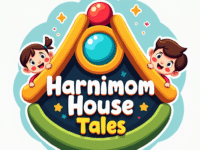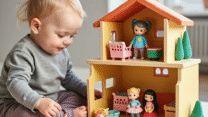
Stories, Solutions & Snuggles – A Gentle Parenting Guide for Toddlers (Ages 1–3)
Introduction
Parenting a toddler is a rollercoaster of emotions-and no two days look the same. One moment your little one is belly-laughing at bubbles, and the next, they’re in full meltdown mode because their toast broke in half. As a mom who’s navigated those exact highs and lows, I know how overwhelming the toddler years can feel. From age one to three, our children go through immense growth spurts—emotionally, physically, and socially—and that often shows up in tantrums, sleep refusal, picky eating, and delayed speech.
That’s why I created this blog: a safe, cozy place for overwhelmed (but deeply loving!) parents. You’ll find gentle parenting tips, evidence-backed guidance, and real-life-tested toddler routines. And because I’m also a children’s book author, you’ll get a peek into the storybooks I write—short, rhythmic tales designed to make your life easier by turning challenges into storytime magic.
Whether your toddler is throwing food across the room, waking up at 2 a.m., or hasn’t said “mama” yet—I’ve been there. Let’s walk this journey together.
Common Toddler Challenges (Ages 1–3)
1. Tantrums and Emotional Outbursts
When my toddler first threw herself on the floor over a sock, I was stunned. But I quickly learned that tantrums are a developmentally normal response to overwhelming emotions. At this stage, toddlers are testing boundaries while still learning how to express needs through words. It’s not misbehavior—it’s communication.
Gentle parenting isn’t about eliminating tantrums but responding to them with empathy. Validating your child’s feelings—like saying, “You wanted the blue cup, and now you’re mad”—helps build emotional regulation. Over time, your toddler learns that feelings are safe and manageable. Tantrums become teachable moments.

👉 Shop Here
2. Sleep Resistance
If bedtime feels like a nightly battle, you’re not alone. Between 18 and 36 months, toddlers commonly struggle with sleep—resisting bedtime, waking often, or becoming fearful of the dark. Their growing independence and fear of missing out make it hard to wind down.
What worked for us? A consistent bedtime routine that felt safe and cozy: bath, dimmed lights, soft pajamas, and the same gentle bedtime story every night. Sleep training for toddlers doesn’t have to be rigid. Familiar books with repetition and a calming pace helped my child transition from playtime to dreamland with fewer tears and more cuddles.
👉 Browse Collection
3. Picky Eating and Mealtime Meltdowns
Toddler nutrition often feels like a guessing game. One day they love bananas, the next day they act like you served them poison. Around age two, many toddlers enter the picky eating phase, asserting control by rejecting foods—even ones they previously liked.
Instead of bribing or pressuring, we created a stress-free mealtime environment. I’d serve tiny portions of something new alongside safe favorites, and we’d tell silly stories about a raccoon who loved broccoli or a bunny who tried beets. Making food fun (not forced!) changed everything. Slowly, meals became moments of joy instead of stress.
4. Speech Delays and Language Frustration
Every toddler develops speech at their own pace, but it can be worrisome when your child isn’t talking as much as others. Around 18 months, many children have 10–20 words; by two years, about 50. But there’s a wide range, especially for boys or bilingual children.
What helped us most was consistent storytelling. Reading toddler storybooks filled with rhythm, repetition, and simple language gave my child a gentle entry into speech. I’d pause before finishing sentences and celebrate any word attempts. One day, they pointed to a page and said, “Night-night moon.” That single phrase felt like winning the lottery. Reading became our daily speech therapy.
5. Social Anxiety, Sharing & Big Emotions
Learning to share, take turns, or separate from a parent is incredibly hard for toddlers. These skills require empathy and emotional regulation—both still developing. My toddler often clung to me at playdates or snatched toys from friends. Instead of punishing, I practiced gentle redirection.
I’d say, “You really want that toy. Let’s wait until it’s your turn.” We’d read books about friendship and feelings—stories where characters worked through similar situations. Over time, these lessons stuck. Sharing still isn’t perfect, but now it’s something we work on with empathy instead of shame.
👉 Start Shopping
Why Stories Help With Toddler Challenges
Reading with toddlers is one of the best ways to nurture their development. Toddler books with simple text, repetitive phrases, and rhythmic language support speech development, emotional growth, and early learning skills.
Books like “Goodnight Moon” or “Brown Bear, Brown Bear” are toddler favorites for a reason. They create predictability. Familiar stories calm the nervous system and build attention spans. When a toddler hears about a bear feeling sad or a bunny being brave, they learn how to name and process their own emotions.
Personally, stories have been our saving grace. On the toughest days—after tantrums or sleepless nights—a quiet reading session reset the mood. It’s like pressing pause on the chaos and connecting heart-to-heart.
Supporting Speech Through Repetition
If your toddler has a speech delay, don’t panic. One of the most helpful things you can do is read repetitive books aloud every day. Rhyming toddler storybooks give your child multiple chances to hear and eventually say the same words.
Try pausing during a familiar line—like, “Brown Bear, Brown Bear, what do you…?” and let them finish. This builds confidence and makes reading interactive. My child used to whisper the last word and beam with pride. Those small moments matter—they’re stepping stones to full conversation.
Picky Eating and Storytelling
Meal refusal used to make me anxious—until I realized storytelling could help. We’d read a silly book about a bear trying new foods or tell an impromptu tale about a brave monkey who tried mushrooms. Suddenly, eating wasn’t scary—it was part of a fun adventure.
Storytelling makes toddlers curious, not cautious. When a food is introduced in a story before it hits the plate, it feels familiar. For picky eaters, that emotional safety is everything. That’s why my storybooks include characters who try new foods, make messes, and giggle through it all.
Encouraging Emotional Regulation Through Stories
Toddlers hit, yell, throw, and cry—not out of spite, but overwhelm. They lack the words and maturity to self-regulate. But stories give them a way to see emotional experiences modeled gently.
In our house, we told a bedtime story about a little bird who flapped with fury, then took deep breaths to feel better. A week later, my toddler flapped their arms and said, “Breathe like bird.” That’s when I knew stories were more than fun—they were teaching tools.
Books about emotions help toddlers understand that feelings are natural and manageable. Reading these stories together opens the door to deeper conversations and better behavior over time.
How This Blog Supports Parents (and Introduces My Books)
Every book I write is inspired by real toddler parenting struggles—ones I’ve lived firsthand. From bedtime battles to food refusal and big feelings, I turn those moments into toddler-friendly stories that soothe and teach.
My storybooks are written with:
- Rhythm and repetition to support language development
- Gentle themes like sharing, bedtime, and trying new foods
- Warm illustrations and bonus printable pages
On this blog, you’ll find free toddler parenting tips, reading routines, and previews of each storybook. These are tools I wish I had when I was in the thick of toddlerhood—and now I’m honored to share them with you.
Tips for Creating Your Own Toddler Routine
Whether you’re building a bedtime routine or creating a storytime habit, here are toddler-tested tips that work:
- Choose a consistent time and cozy place for reading
- Let your toddler pick their favorite books
- Read slowly and use a calming voice
- Repeat beloved books often (yes, even ten times!)
- Ask questions like “What do you see?” or “How do you think the bunny feels?”
For us, the bedtime cue was a warm lamp and a stack of toddler books by the cushion. Over time, this reading routine became our anchor—and bedtime became something we both looked forward to.
Printable Charts to Support Toddler Emotions
My Storybook Launch!
I’m so excited to launch my toddler storybook collection—designed especially for parents who want gentle support for daily challenges. These are short, simple, emotionally smart stories you’ll actually enjoy reading again and again.
Each book includes:
- A read-aloud toddler story with repetition and rhythm
- Gentle solutions to everyday challenges
- Printable activity pages to reinforce the theme
Whether you need a bedtime solution or a fun way to talk about feelings, there’s a story to help. Subscribe now so you don’t miss the launch!
👉Check here
Conclusion
Parenting toddlers isn’t easy—but it’s rich with growth, connection, and joy. With the right stories, routines, and mindset, you can turn chaos into calm and meltdowns into moments of learning.
This blog is your soft place to land. You’ll find toddler behavior help, early learning ideas, and gentle stories that meet you where you are.
If you’re looking for help with sleep, picky eating, toddler speech delays, or big feelings—you’re in the right place.
Subscribe for free stories, printables, and updates. Together, let’s make toddlerhood a little gentler.
With warmth and understanding,
Harnimom.












